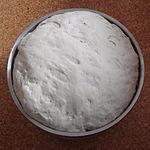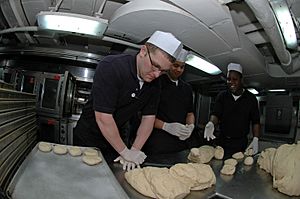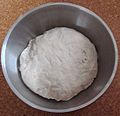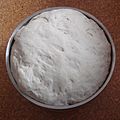Straight dough facts for kids
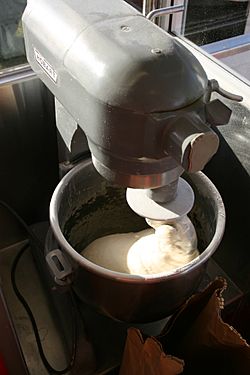
Dough being mixed in a commercial planetary mixer.
|
|
| Main ingredients | Wheat flour, water. |
|---|---|
Straight dough is a simple way to make bread or other baked goods. It's called "straight" because you mix all the fresh ingredients together at once. After mixing, the dough rests and rises for about an hour or more before you shape it. This method is also known as the direct dough method.
How to Make Straight Dough
Making straight dough involves several steps, from getting ready to baking. It's like following a recipe, but with some special baking terms.
Your Recipe: The Formula
A straight dough recipe, often called a "formula" by bakers, lists all the ingredients and their amounts. Bakers often use something called "Baker's percentage." This means they compare every ingredient's weight to the flour's weight, which is always 100%. This helps them easily change the recipe size.
| Baker's percentage |
|
|---|---|
| ingredient | % |
| flour | 100% |
| water | 60% |
| sugar | 4% |
| fat | 4% |
| yeast | 1%–5% |
| salt | 2% |
Getting Ready: Mise en Place
The first step is to get everything ready. This means:
- Reading your recipe carefully.
- Gathering all your ingredients.
- Making sure you have all the tools you need, like bowls and mixers.
- Thinking about how much dough you want to make and how long it will take.
Weighing Your Ingredients
This step is also called scaling. It's very important to weigh your ingredients accurately, especially in baking. If you use too much yeast, for example, your dough might rise too fast and have a strong yeast taste.
Mixing the Dough
All the ingredients are put into a mixing bowl at the same time and mixed together. You can mix the dough by hand, which is called kneading, or use a machine. Mixing helps the ingredients combine and starts to develop the dough's structure.
Mixing also adds a little heat to the dough. Bakers sometimes use cold water or even crushed ice to keep the dough from getting too warm, as warmer dough can lose some color and flavor.
First Rise: Bulk Fermentation
After mixing, the dough needs to rest and rise. This is called bulk fermentation. You put the dough in a large bowl, usually in a warm place, and cover it. Covering the bowl keeps the dough moist so it doesn't dry out.
As the dough rests, the yeast in it creates carbon dioxide gas. This gas makes the dough expand and grow in volume. The dough will rise to a certain point, then it might start to slowly fall.
Punching Down and Folding
When the dough has risen enough, you take it out of the bowl. You might gently stretch and fold it on a lightly floured surface. This step is also called degassing, knock back, or punch down.
- Degassing means gently pressing out some of the gas bubbles that have formed.
- Stretching and folding helps to strengthen the gluten in the dough. Gluten is what gives bread its chewy texture. It also helps to make the dough temperature even throughout.
After folding, the dough goes back into the bowl to continue rising. For doughs that rise for a long time, you might do several folding sessions.
Shaping Your Bread: Make-up
Once the bulk fermentation is done, it's time to get the dough ready for its final shape.
- Dividing: If you're making more than one loaf or many rolls, you'll divide the large dough into smaller pieces. This is also called scaling or portioning.
- Pre-shaping: You might gently shape the dough pieces into basic rounds, ovals, or cylinders. This helps prepare them for their final shape.
- Bench Proofing: The dough pieces then get a short rest, usually 8 to 30 minutes. This rest period helps the dough relax, making it easier to shape later.
- Shaping: Finally, you shape each piece of dough into its desired form, like a loaf, a roll, or a baguette. Then you place it on a baking tray or in a pan.
Final Rise: Proofing
Proofing is the last rise the dough takes before it's baked. Like the first rise, proofing is best done in a warm, slightly humid place. The yeast works best in temperatures between 70°F and 95°F (21°C and 35°C). Warmer temperatures make the yeast work faster.
During proofing, the dough expands until it's almost its final size.
Scoring the Dough
If you want, you can make cuts on the top of the proofed dough with a special tool called a lame or a razor. This is called scoring. Scoring helps control where the bread expands in the oven and can also make pretty designs on the crust.
Baking the Bread
The proofed dough is carefully placed into a hot oven. In the first few minutes of baking, the dough will have a final burst of rising, which bakers call oven spring. The yeast dies as the dough gets hotter, and the baking is finished when the inside of the bread reaches about 208°F to 210°F (98°C to 99°C).
Cooling Down
Once the bread is fully baked, it's taken out of the oven and placed on racks to cool down. It's best to wait until the bread has cooled to about 95°F to 105°F (35°C to 41°C) before slicing it. This helps the bread's texture and flavor develop fully.
History of Straight Dough
The straight dough method became popular after people learned how to make and mass-produce baker's yeast and mixing machines. Before this, many bakers used a method called "sponge and dough" or even sourdough.
Straight dough was simpler and took less time and effort. It was seen as a better method for making bread in larger amounts for businesses. By the 1930s, straight dough had mostly replaced other methods for many bakers, especially in cities.
Images for kids
See also
 In Spanish: Masa directa para niños
In Spanish: Masa directa para niños




